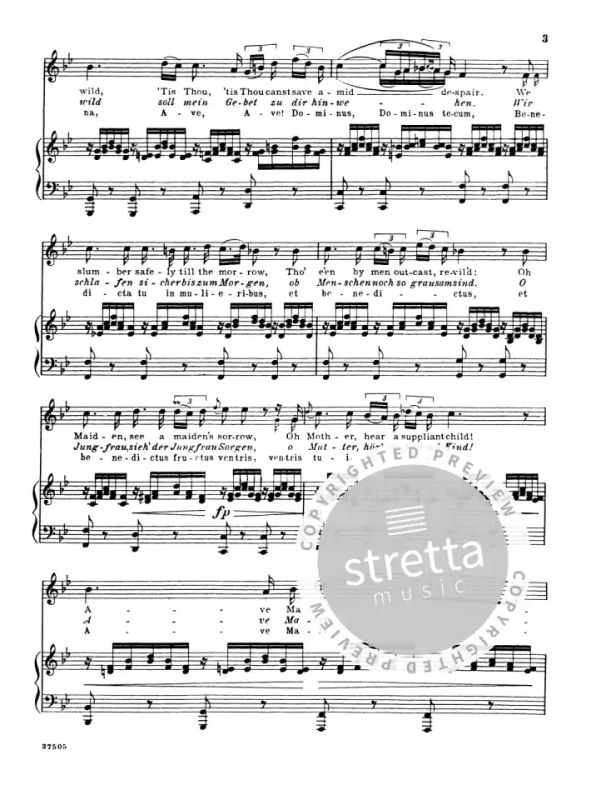

The opening words and refrain of Ellen's song, namely " Ave Maria" (Latin for "Hail Mary"), may have led to the idea of adapting Schubert's melody as a setting for the full text of the traditional Roman Catholic prayer, " Ave Maria". Schubert's setting is said to have first been performed at the castle of Countess Sophie Weissenwolff in the little Austrian town of Steyregg and dedicated to her, which led to her becoming known as "the lady of the lake" herself.



Roderick Dhu pauses, then goes on to battle. Roderick Dhu, the chieftain of Clan Alpine, sets off up the mountain with his warriors, but lingers and hears the distant sound of the harpist Allan-bane, accompanying Ellen who sings a prayer addressed to the Virgin Mary, calling upon her for help. In Scott's poem, the character Ellen Douglas, the Lady of the Lake ( Loch Katrine in the Scottish Highlands), has gone with her exiled father to stay in the Goblin's cave as he has declined to join their previous host, Roderick Dhu, in rebellion against King James. The piece was composed as a setting of a song (verse XXIX from Canto Three) from Walter Scott's popular narrative poem The Lady of the Lake, in a German translation by Adam Storck (1780–1822), and thus forms part of Schubert's Liederzyklus vom Fräulein vom See. The Lady of the Lake and the "Ave Maria" 1879 painting of Ellen's Isle, Loch Katrine It was arranged in three versions for piano by Franz Liszt. Beyond the song as originally composed by Schubert, it is often performed and recorded by many singers under the title " Ave Maria" (the Latin name of the prayer Hail Mary, and also the opening words and refrain of Ellen's song, a song which is itself a prayer to the Virgin Mary), in musically simplified arrangements and with various lyrics that commonly differ from the original context of the poem. It is one of Schubert's most popular works. 52, a setting of seven songs from Walter Scott's 1810 popular narrative poem The Lady of the Lake, loosely translated into German. 6, 1825), in English: " Ellen's Third Song", was composed by Franz Schubert in 1825 as part of his Op. " Ellens dritter Gesang" (" Ellens Gesang III", D. To learn more about how and for what purposes Amazon uses personal information (such as Amazon Store order history), please visit our Privacy Notice.Song by Franz Schubert Portrait of Franz Schubert by Franz Eybl (1827) Walter Scott You can change your choices at any time by visiting Cookie Preferences, as described in the Cookie Notice. Click ‘Customise Cookies’ to decline these cookies, make more detailed choices, or learn more. Third parties use cookies for their purposes of displaying and measuring personalised ads, generating audience insights, and developing and improving products. This includes using first- and third-party cookies, which store or access standard device information such as a unique identifier. If you agree, we’ll also use cookies to complement your shopping experience across the Amazon stores as described in our Cookie Notice. We also use these cookies to understand how customers use our services (for example, by measuring site visits) so we can make improvements. We use cookies and similar tools that are necessary to enable you to make purchases, to enhance your shopping experiences and to provide our services, as detailed in our Cookie Notice.


 0 kommentar(er)
0 kommentar(er)
